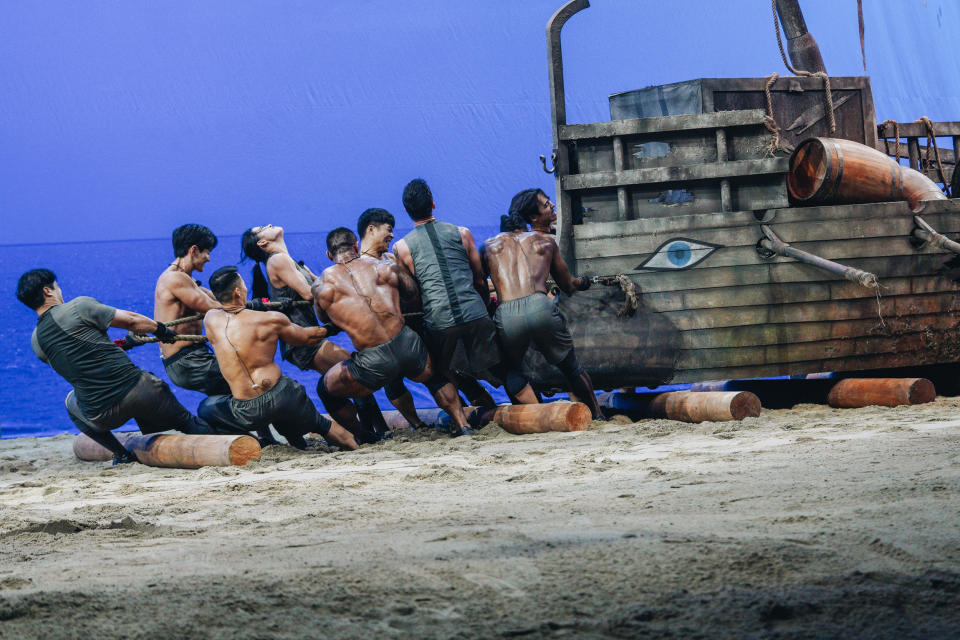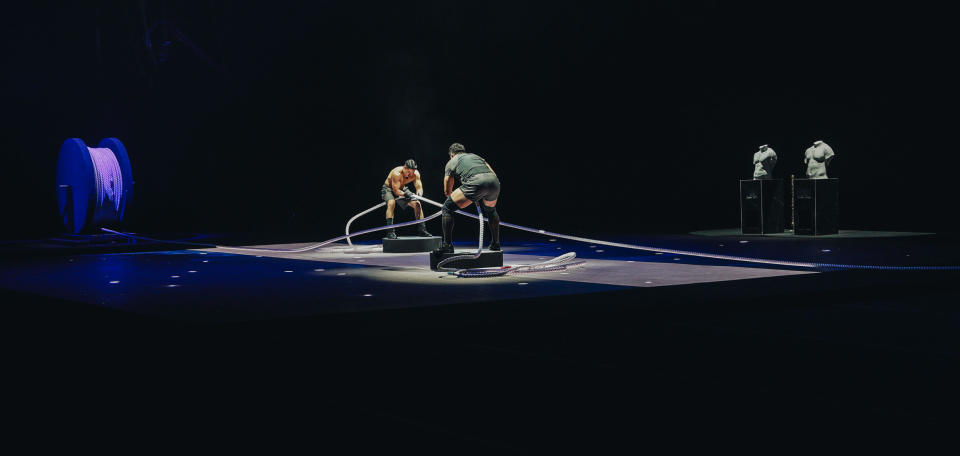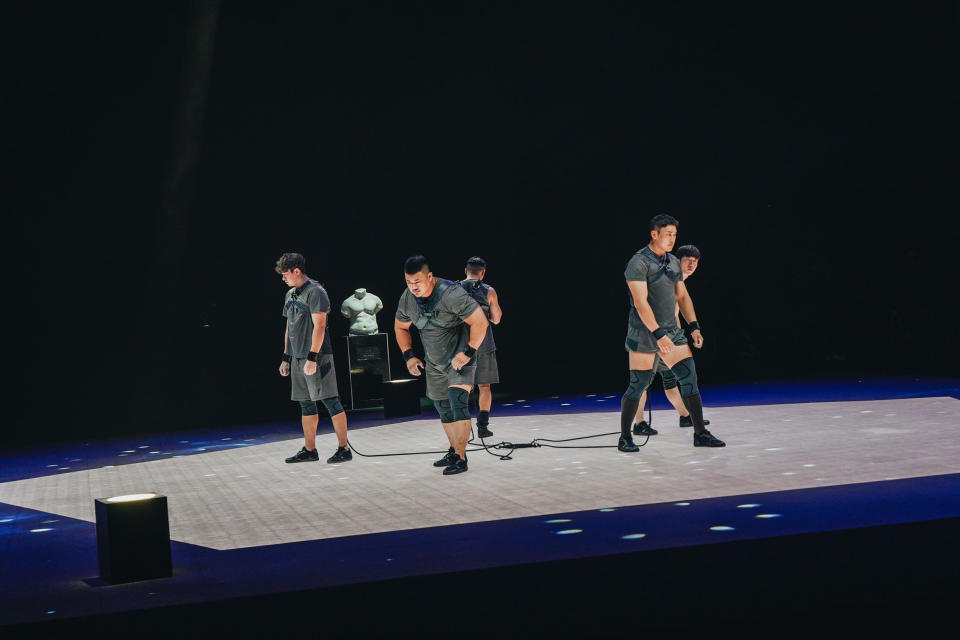How 'Physical 100,' Netflix's Korean reality gauntlet, destroys misconceptions around Asian bodies
A reality show that centers around superhuman physique and strength could have the power to, in part, challenge long-standing perceptions of Asian bodies, experts say.
“Physical 100,” Netflix’s Korean reality gauntlet, invited 100 predominantly Asian athletes to compete for the title of the ultimate human physique. With competitors who encompass a vast range of body types and athletic expertise, experts say the show bucks negative stereotypes around Asian physical ability while powerfully expanding the often narrow definitions of what strong, fit and masculine bodies look like — particularly to Western audiences.
But experts say it’s not without glimpses into the sexism pervasive in sports and Korean culture itself, along with an overemphasis on physical perfection. As the season wrapped up with its finale Tuesday, many critics say the reality series is a messy, complicated step forward for Asian representation on the global stage.
“The major contribution here is that it completely destabilizes the ways we link up race and ability,” said Stanley Thangaraj, author of “Desi Hoop Dreams: Pickup Basketball and the Making of Asian American Masculinity.”

In the nine-episode season, athletes compete in a series of seemingly impossible physical challenges, from a one-on-one deathmatch to pulling a 1.5-ton ship across sand to participating in the real-life version of the punishments doled out by gods in Greek mythology. Losers are eliminated each round.
The contestants do not all fit under a singular archetype of strength. Lugers, wrestlers, climbers, fitness influencers and more all compete side by side. Some familiar faces are in the mix, too, like Korean Olympic gold medalist Yang Hak-seon, a gymnast, and celebrated MMA fighter Choo Sung-hoon, who’s better known as Sexyama.
Christina Chin, an associate professor of sociology at California State University, Fullerton, said that historically, Western perceptions of strength are often imagined on white and Black bodies. Asians are either degraded or too often left out of that conversation entirely. The show’s predominantly Asian cast disrupts that dynamic, and viewers are able to see the contestants beyond race and for their skill.
“We often don’t think of Asians as being able to compete in physical competitions. But in a show like this, race is not the criteria for being the underdog,” she said. “It’s actually like because they’re a dancer or a model, a farmer.”

The body diversity on the show is also significant in complicating Western perceptions of physical fitness and strength — which are often limited to manufactured, Hollywood six-pack abs, Chin said. While some are covered in bulging muscles from top to bottom, others are lanky and lean. Some contestants have bellies and broad shoulders. And no one body type is universally superior. As the episodes progress, different challenges end up benefiting different physiques. So, across challenges, athletes with no muscle definition can come out as successful as those with a lot of it. Respect is commonly shown by the contestants for their competitors’ unique attributes.
“It’s really creating a space where we see strength, power and athleticism in a variety of different ways — ways that we’ve never seen from a U.S. perspective,” Chin said. “It’s going to really ask viewers to think differently, and to break out of our sort of stereotypical idea of what that perfect physique looks like.”
The show is also powerful for those within the Asian diaspora itself, Thangaraj said. The group is still rarely depicted outside of stereotypical corporate, robotic or sidekick roles — much less in arenas of fun and leisure like sports.
But with an entire show dedicated to athletes, all with unique stories outside of just mainstream institutions rife with gatekeepers like basketball or football, “Physical 100” helps change the game.

“It is not a strength that is couched in mainstream sports where there’s so many barriers and such difficulties entering into that realm,” he said. “Here the focus on strength through a wide variety of abilities and comportments allows us to really see a near possibility. We can almost imagine ourselves in there.”
The women on the show also powerfully challenge the stereotype that Asian women can be weak and hyperfeminine, the experts say. Like their male counterparts, the women are leaders in sports from bodybuilding to wrestling. And they aren’t shy about showing off their toned arms and broad shoulders. The show, in part, Thangaraj said, “completely dismantles” the limited notion of Asian and Asian American womanhood.
Rachael Joo, an associate professor of American studies at Middlebury College, whose research focuses on sporting media and South Korean and Korean American communities, underscored that the show still has a sexism problem. While it claims to search for the perfect physique, “regardless of gender, age and race,” the women on the show are eliminated early, already dwindling in numbers by the third episode. The rules may be equal, Joo said, but they aren’t equitable.
Some of the contestants also display unchecked sexism, Joo said. Many of the male competitors regard their female peers as weaker links, unable to see them as formidable opponents. And in some of the co-ed deathmatches, male contestants received backlash for how they appeared to behave against their female competitors.
Netflix did not respond to NBC News' request for comment
Joo said it coincides with a heightened attitude against gender equality in South Korea.
Critics say the anti-feminist movement in the country has gained steam in recent years, particularly under President Yoon Suk Yeol, who in October announced his intention to abolish the country’s Ministry of Gender Equality and Family.
“That … to me was so indicative of this rising anti-female sentiment in Korea,” Joo said. “Like, ‘Women don’t belong here and I’m going to put you in your place and I’ll just show you with as little effort why.’”
Chin similarly noted that the show was a “missed opportunity” to address or correct the pervasive sexism.
And while the vast collection of strong, athletic Asian bodies on the show is a powerful sight for Western audiences, the focus on physique and physical fitness has become increasingly integral to success in Korean society, Joo said. That’s not always healthy.
“There’s a lot that’s been written on plastic surgery in Korea, and in many ways, it’s a corollary to that, where body perfection is just another way to show that you’re a little better than the person next to you,” Joo said. “People who are looking for jobs in their 20s, maybe even 30s, are expected to work at this as a part of their-self improvement.”
There’s still a long way to go before Asian bodies are portrayed in a nuanced and responsible way. But experts say that the show will undoubtedly change a few minds.
“Size and muscularity is not the definition of strength and fitness that we’ve all always assumed,” Thangaraj said. “Rather it forces us to think about the ways in which these athletes have trained and put in time and put in devotion and put in passion.”
This article was originally published on NBCNews.com

